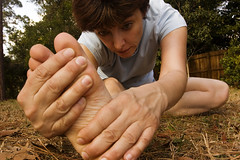
A few weeks ago, Julie (Timmermans from CTE) and I visited Bishop’s University to facilitate two workshops. The morning session was on course design, a condensed version of CTE’s Course Design Fundamentals. In the afternoon, the session was titled, “Designing Assessment for Learning”. We had an absolutely wonderful time and met many faculty members from both Bishop’s University and Champlain College, which is also located in Lennoxville.
We struggled for quite some time with the content of the assessment workshop. Whole university courses are dedicated to this topic. We had just three hours. What should we cover? What were the most critical messages? Should we focus on specific tools? What are some of the “best practices” that are happening at Waterloo that we should share? Should we spend an equal amount of time on both formative and summative assessment? Wow! There is so much to cover.
OK. Perhaps we could focus the assessment plan (as our intention was that the take-away from the workshop would be to have an assessment plan) around a few specific assessment tools. But what should we include? Exams? Quizzes? Assignments? Written assignments? Problem sets? Labs? Projects? Research? Essays? Community Service? Design Competitions? Case Studies? Reports? Studio projects? Individual work? Team work? Participation? Reflective Writing? Again, what a lot of content to cover in just three hours!
Our initial thoughts and design focused heavily on content and all the knowledge we wanted to impart. Ironic given the fact that we had just planned a course design workshop. We eventually took our own advice and stepped away from the content. As we continued to wrestle with these ideas, we kept asking ourselves, if there is just one thing we would like participants to know or have when they walked out the door, what would it be? It took a really, really long time to figure this out.
Eventually, we realized that we wanted participants to explore a different element of assessment. While we could impart lots of ideas related to specific tools, we decided to focus instead on how we view and value assessment. We began the workshop with an exploration of the concerns we, as instructors, have about assessment then compared it with our perceptions of students’ concerns about assessment. We then explored elements of a framework for assessment, which includes: observation (obtaining evidence of learning); interpretation (reasoning from the evidence); learning outcomes; and, at the centre of the framework, the purpose (Why am I assessing?) (the framework we presented was adapted from the National Research Council (2001). Knowing What Students Know. Washington, DC: National Academy Press, p. 44.).
Both these pieces led to the final activity of the day, in which we asked participants to articulate their Assessment Philosophy Plan, which might eventually become part of their Teaching Philosophy. The idea was to explore what their goals and philosophy were for the assessment of their students. We asked them to reflect on the following questions.
- Who is involved with the assessment?
- What roles does assessment play in learning?
- What boundaries surround your assessment framework?
- How can you provide flexibility to support the variety of learners in your class?
- What pieces are rigid and which ones are flexible?
Having written this philosophy statement, we then asked them to reflect on how the assessments in their course reflect this philosophy. In reality, we cannot always control the contextual factors that impact our assessment choice (e.g., if part of our philosophy relates to developing a reflective practice, how do we provide formative feedback to a class of 1500?). But by reflecting and articulating our own philosophy, it can help guide us when we need to make some of the more difficult decisions tied to our assessment strategy for our course.

 Learning, in many university students’ minds, is reading textbooks and attending lectures. Yes, this is one way to learn, but it should not be the only way for students to learn. It is true that students can learn knowledge by this way, but is this the best way for students to learn? Also, other than knowledge, what can they learn from just reading textbooks and attending lectures?
Learning, in many university students’ minds, is reading textbooks and attending lectures. Yes, this is one way to learn, but it should not be the only way for students to learn. It is true that students can learn knowledge by this way, but is this the best way for students to learn? Also, other than knowledge, what can they learn from just reading textbooks and attending lectures?
 Consider the following question:
Consider the following question:
